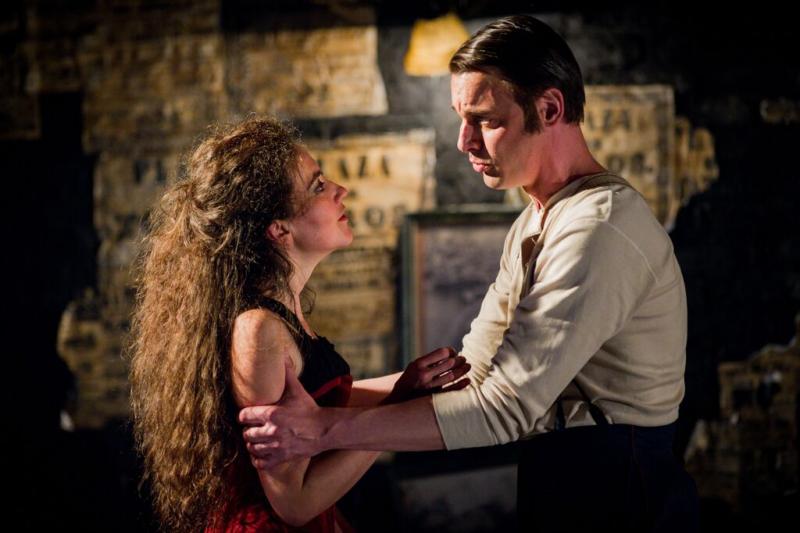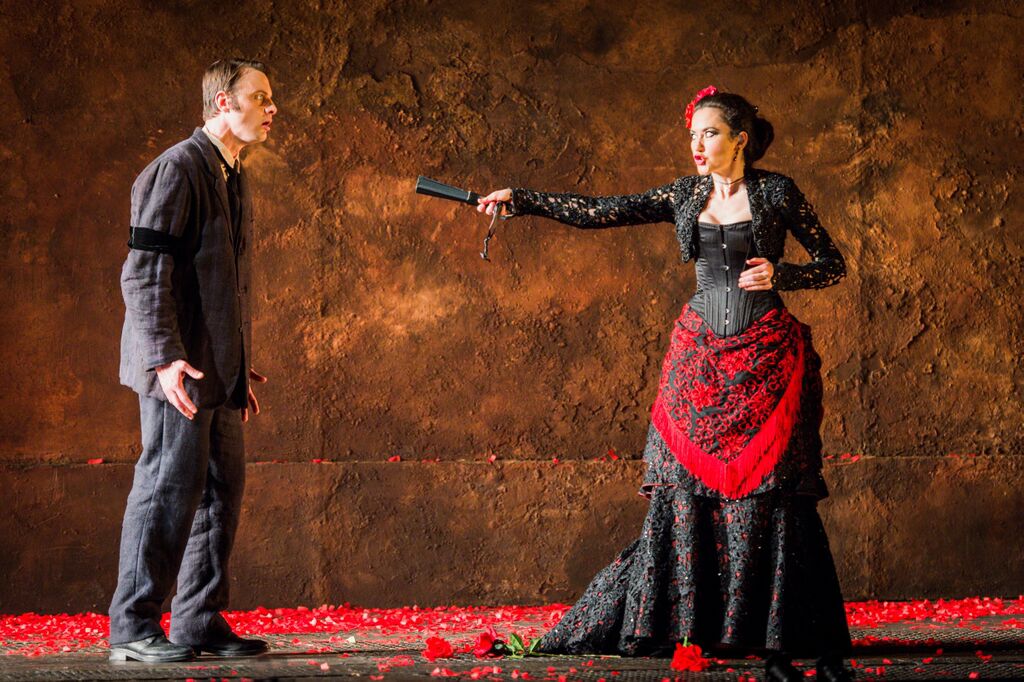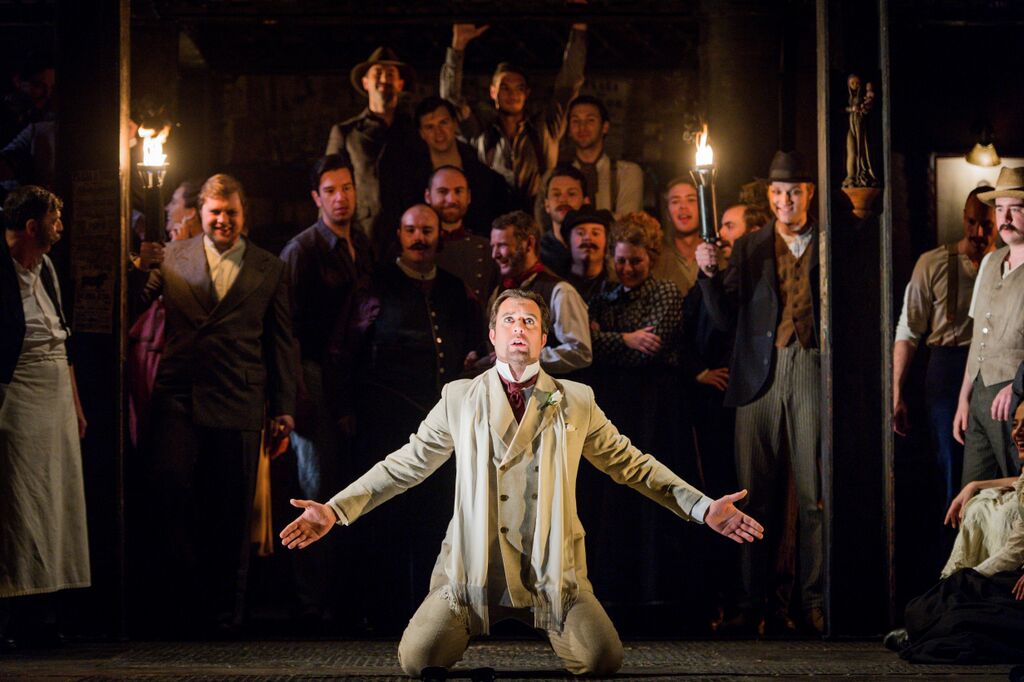Carmen, Glyndebourne Festival Opera | reviews, news & interviews
Carmen, Glyndebourne Festival Opera
Carmen, Glyndebourne Festival Opera
Fresh revival with strong cast and dynamic conducting from Jakub Hrůša

After Calixto Bieito’s radical reimaging of Carmen, which opened at English National Opera this week, David McVicar’s version at Glyndebourne was bound to seem conservative. But it turned out to be a comparison of apples and Seville oranges: Bieito is certainly bolder, but McVicar is more sophisticated and digs deeper into the raw emotions of the work.
McVicar sets his Carmen in the mid-to-late 19th century, a gentle updating that is most evident in the Act I set. The tobacco factory is presented as a mechanised and industrial affair, but in a state of decay. A large broken cog sits at one side of the stage and the colour scheme is rust-red. All very steam punk. In the second act, Pastia’s inn is in a small basement, entered from the street, visible above. The sets for the first two acts are large, but they force the action into the very front of the stage. That requires some imaginative positioning of the chorus, dancers, actors and children, who always seem to be competing for space, but it also serves to focus and concentrate the action. The stage opens out in the third act, the smuggler’s hideout a bare stage with just a wagon of booty in the centre and much dry ice for fog. And the finale takes place in front of a towering bullring wall, its ochre hue a visual reference to the rust red of Act I.
 Characters are finely drawn and carefully observed. Particularly impressive is Don José, sung by the Czech tenor Pavel Cernoch. His transformation and decline animates the production, from his first appearance as a shy and disinterested career soldier in Act I to the very credible murderer at the end (pictured right, the final confrontation). The final stages of his descent are perfectly realised at the end of Act III, as he stabs wildly with his knife into the engulfing fog, the offstage Toreador’s Song a phantom haunting his thoughts. Cernoch has a soft voice for the part, but it is agile, lyrical, and always secure.
Characters are finely drawn and carefully observed. Particularly impressive is Don José, sung by the Czech tenor Pavel Cernoch. His transformation and decline animates the production, from his first appearance as a shy and disinterested career soldier in Act I to the very credible murderer at the end (pictured right, the final confrontation). The final stages of his descent are perfectly realised at the end of Act III, as he stabs wildly with his knife into the engulfing fog, the offstage Toreador’s Song a phantom haunting his thoughts. Cernoch has a soft voice for the part, but it is agile, lyrical, and always secure.
But the evening belonged to Stéphanie d’Oustrac, who was born to play Carmen. She is captivating from start to finish, completely dominating the stage whenever she appears. Again, not a huge voice (she’s better known as a Baroque specialist) but big enough to fill this house. She is always seductive and always gives the impression she’s playing by her own rules. Just listen to the way she pushes and pulls against Hrůša’s beat, teasing him as much as she does Don José, Zuniga and the rest.
 A strong supporting cast with no really weak links. David Soar (pictured left) has a rich tone as Escamillo, although is uncomfortable on some of the low notes. Lucy Crowe sounded a little husky as Micaëla – a slight cold perhaps? – but this never threatened the evenness of her production or the empathy she evoked for the character. (Why bring her back onstage for the dénouement though? That seemed crass.) Simon Lim appears on the cast list but not in the programme as Zuniga, suggesting a late substitution. But he gives far more that an understudy performance, bringing a commanding but agile bass voice to the role.
A strong supporting cast with no really weak links. David Soar (pictured left) has a rich tone as Escamillo, although is uncomfortable on some of the low notes. Lucy Crowe sounded a little husky as Micaëla – a slight cold perhaps? – but this never threatened the evenness of her production or the empathy she evoked for the character. (Why bring her back onstage for the dénouement though? That seemed crass.) Simon Lim appears on the cast list but not in the programme as Zuniga, suggesting a late substitution. But he gives far more that an understudy performance, bringing a commanding but agile bass voice to the role.
Jakub Hrůša leads a dynamic and propulsive reading of the score. Tempos are brisk and accents are clean and firm. One or two awkward transitions mean that some of the set pieces don’t integrate as they might, but that is a small price to pay for such vital, imaginative and engaged music-making.
rating
Explore topics
Share this article
The future of Arts Journalism
You can stop theartsdesk.com closing!
We urgently need financing to survive. Our fundraising drive has thus far raised £49,000 but we need to reach £100,000 or we will be forced to close. Please contribute here: https://gofund.me/c3f6033d
And if you can forward this information to anyone who might assist, we’d be grateful.

Subscribe to theartsdesk.com
Thank you for continuing to read our work on theartsdesk.com. For unlimited access to every article in its entirety, including our archive of more than 15,000 pieces, we're asking for £5 per month or £40 per year. We feel it's a very good deal, and hope you do too.
To take a subscription now simply click here.
And if you're looking for that extra gift for a friend or family member, why not treat them to a theartsdesk.com gift subscription?
more Opera
 Albert Herring, English National Opera review - a great comedy with depths fully realised
Britten’s delight was never made for the Coliseum, but it works on its first outing there
Albert Herring, English National Opera review - a great comedy with depths fully realised
Britten’s delight was never made for the Coliseum, but it works on its first outing there
 Carmen, English National Opera review - not quite dangerous
Hopes for Niamh O’Sullivan only partly fulfilled, though much good singing throughout
Carmen, English National Opera review - not quite dangerous
Hopes for Niamh O’Sullivan only partly fulfilled, though much good singing throughout
 Giustino, Linbury Theatre review - a stylish account of a slight opera
Gods, mortals and monsters do battle in Handel's charming drama
Giustino, Linbury Theatre review - a stylish account of a slight opera
Gods, mortals and monsters do battle in Handel's charming drama
 Susanna, Opera North review - hybrid staging of a Handel oratorio
Dance and signing complement outstanding singing in a story of virtue rewarded
Susanna, Opera North review - hybrid staging of a Handel oratorio
Dance and signing complement outstanding singing in a story of virtue rewarded
 Ariodante, Opéra Garnier, Paris review - a blast of Baroque beauty
A near-perfect night at the opera
Ariodante, Opéra Garnier, Paris review - a blast of Baroque beauty
A near-perfect night at the opera
 Cinderella/La Cenerentola, English National Opera review - the truth behind the tinsel
Appealing performances cut through hyperactive stagecraft
Cinderella/La Cenerentola, English National Opera review - the truth behind the tinsel
Appealing performances cut through hyperactive stagecraft
 Tosca, Royal Opera review - Ailyn Pérez steps in as the most vivid of divas
Jakub Hrůša’s multicoloured Puccini last night found a soprano to match
Tosca, Royal Opera review - Ailyn Pérez steps in as the most vivid of divas
Jakub Hrůša’s multicoloured Puccini last night found a soprano to match
 Tosca, Welsh National Opera review - a great company reduced to brilliance
The old warhorse made special by the basics
Tosca, Welsh National Opera review - a great company reduced to brilliance
The old warhorse made special by the basics
 BBC Proms: The Marriage of Figaro, Glyndebourne Festival review - merriment and menace
Strong Proms transfer for a robust and affecting show
BBC Proms: The Marriage of Figaro, Glyndebourne Festival review - merriment and menace
Strong Proms transfer for a robust and affecting show
 BBC Proms: Suor Angelica, LSO, Pappano review - earthly passion, heavenly grief
A Sister to remember blesses Puccini's convent tragedy
BBC Proms: Suor Angelica, LSO, Pappano review - earthly passion, heavenly grief
A Sister to remember blesses Puccini's convent tragedy
 Orpheus and Eurydice, Opera Queensland/SCO, Edinburgh International Festival 2025 review - dazzling, but distracting
Eye-popping acrobatics don’t always assist in Gluck’s quest for operatic truth
Orpheus and Eurydice, Opera Queensland/SCO, Edinburgh International Festival 2025 review - dazzling, but distracting
Eye-popping acrobatics don’t always assist in Gluck’s quest for operatic truth
 MARS, Irish National Opera review - silly space oddity with fun stretches
Cast, orchestra and production give Jennifer Walshe’s bold collage their all
MARS, Irish National Opera review - silly space oddity with fun stretches
Cast, orchestra and production give Jennifer Walshe’s bold collage their all

Add comment